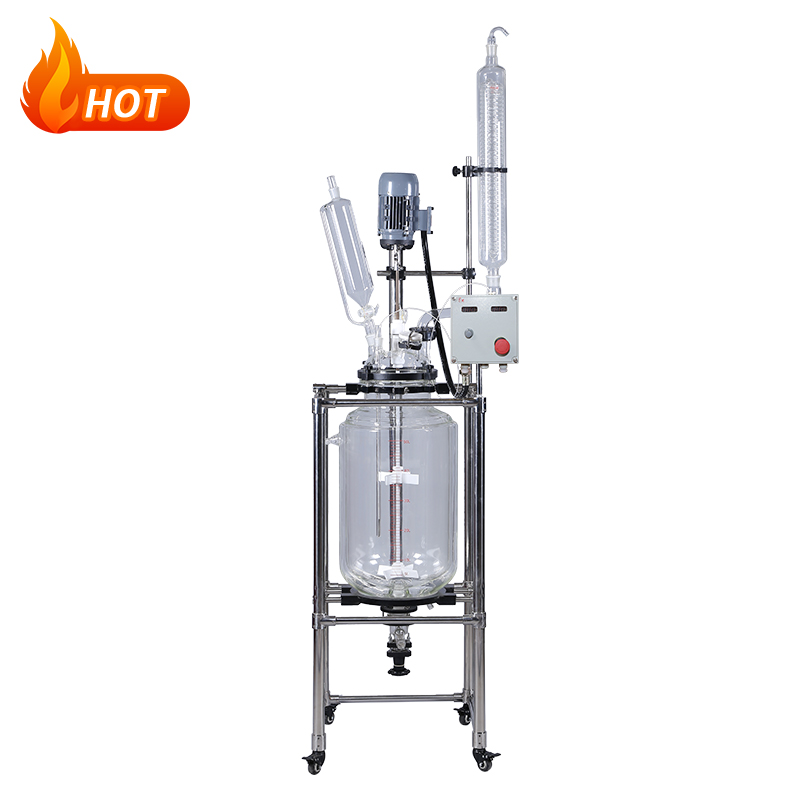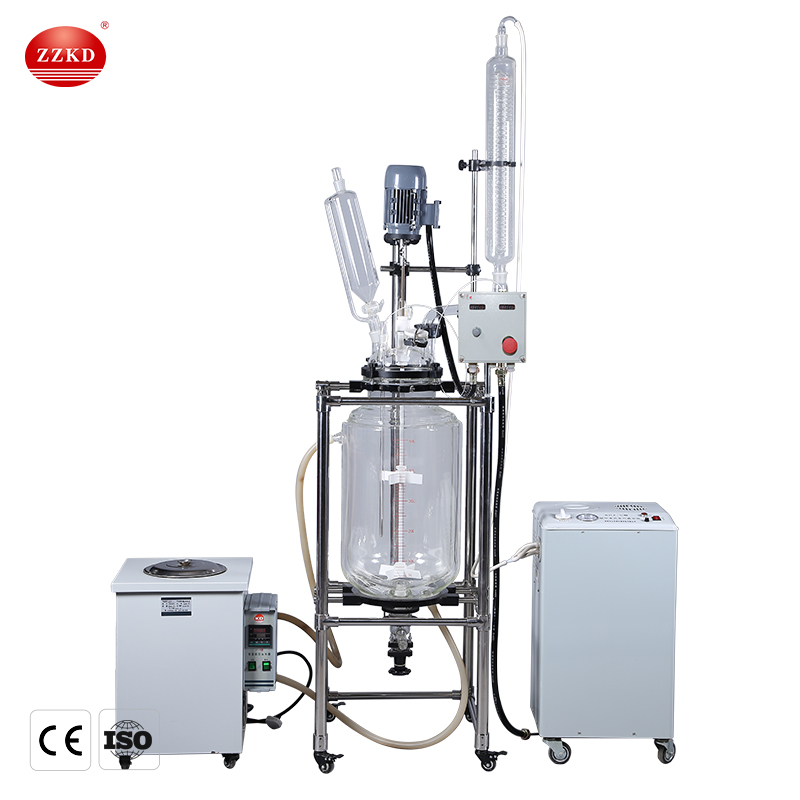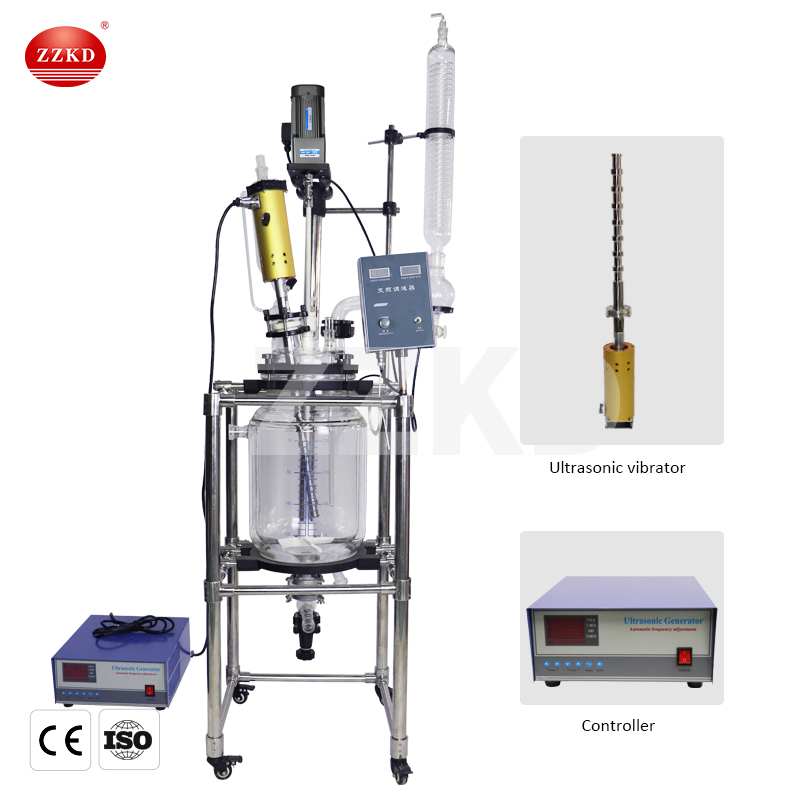Double Jacketed Glass Reactor
Today, let's talk about the working principle and characteristics of the double-jacketed glass reactor, and then explain in detail the maintenance methods and precautions for the use of the double jacketed glass reactor.
The working principle of the double 100l glass reactor is through the interlayer of the double-layer reactor, injecting a constant temperature (high temperature or low temperature) hot melt medium or cooling medium to heat or cool the materials in the reactor at a constant temperature, and can provide stirring. The materials are reacted in the double jacketed glass reactor kettle, and the evaporation and reflux of the reaction solution are controlled. After completion, the materials can be taken out from the discharge port at the bottom of the kettle, and the operation is convenient. It is an ideal equipment for modern chemical experiments and biopharmaceuticals.

Main features of double jacketed glass reactor:
1. Frequency conversion speed regulation, AC induction motor. Constant speed, no sparks, safe and stable, and can work continuously.
2. The whole set of glass instruments is produced with GG17 high borosilicate glass, which has good chemical and physical properties.
3. It can be reacted at room temperature, and the reflected heat can be quickly taken away by running tap water.
4. The lower discharge port of the double-jacketed glass reaction kettle is equipped with a flange port and a polytetrafluoro valve. There is no dead angle in the reaction kettle container, and it can be disassembled to facilitate the discharge of solid materials.
5. The five-port reactor cover, the extra-large port design is easy to clean, and the standard port socket can be selected to assemble the reflux and distillation synthesis device.
Structural characteristics of double jacketed glass reactor:
1. The glass reactor is a double-layer design, made of GG17 high borosilicate glass, and the middle jacket can be fed with hot solvent for high temperature reaction (the maximum temperature can reach 300°C, and the middle jacket can also be fed with cold solvent for low temperature and constant temperature reaction) (The lowest temperature can reach - 80°C); the high borosilicate glass produced by our factory has been proved by the current experiment that it can accept a large temperature difference. The design of the interlayer has a good thermal insulation effect and is a good choice for constant temperature reaction. Effective volume : 100L;
2. The fixing bracket of the glass reactor is made of 304 stainless steel, which is easy to operate, has good stability and can move smoothly;
3. Double-layer glass reaction kettle adopts high-power stirring motor, universal joint connection, digital display temperature, digital display variable frequency speed controller, stirring torque is 15000g.cm (rotation speed is 480/min); no spark, safe and reliable life long.
4. It is equipped with upper and lower layers of stirring; the stirring rod is made of stainless steel and the outer core is made of PTFE;
5. The lid of the glass reaction kettle is a standard six-port design, the lid opening is 50# (stirring), 50# (condensation), 34# (vent valve), 40# (constant pressure funnel), 24# (temperature measurement ) port, 80# flange solid feeding port.
6. The stirring shaft is mechanically sealed, with good air tightness, no air leakage, and excellent chemical resistance; it can withstand various solvents and maintain a high degree of vacuum, which is very convenient to use.
7. The lower discharge material is designed to be a new type of removable thimble, which is convenient for the smooth discharge of solids, particles and reaction materials with high viscosity. No dead ends, no clamping

Daily maintenance of double jacketed glass reactor:
1. Carefully check the instrument before use, whether the glass bottle is damaged, whether each interface is kissed, and pay attention to handle it with care.
2. Wipe each interface with a soft cloth and apply a little vacuum grease.
3. Each interface can be loosened a little, and loosen the joint regularly to avoid the connector being too tight due to long-term locking.
4. Turn on the power switch and let the machine run from slow to fast. When the machine is in a stopped state, turn off the switch.
5. The switches everywhere should not be over-tightened, as it is easy to damage the glass.
6. After each use, all kinds of oil stains, stains and solvent residues left on the surface of the machine must be wiped off with a soft cloth to keep it clean.
7. Unscrew the switch after stopping, the long-term static working state may deform the PTFE piston.
8. Clean the sealing ring regularly. The cleaning method is: remove the sealing ring, check the shaft for dirt, wipe it with a soft cloth, apply a little vacuum grease, reinstall it, and keep the shaft and the seal.
9. It is necessary to purchase genuine parts from the original factory. The use of other parts will cause fatal damage to the machine.

Instructions for use of double jacketed glass reactor:
1.Before installation, use, maintenance, and inspection, be sure to read the entire contents of this manual carefully and use it correctly.
2.The power supply voltage must be the same as that specified by this instrument.
3.The machine should not run at high speed when there is no material.
4.The service life of the electrical box is greatly affected by the surrounding temperature and humidity. So please keep the governor and motor dry.
5.Install the machine first, then wire it by a professional electrician, and turn it on. The ground terminal must be grounded. The high temperature bath must be switched on.
6.Within 5 minutes after the power is turned off, electric shock may still occur due to the discharge of the inverter or capacitor.
7.When working, pay attention to the impact damage to the glass by hard objects (watches, rings, belt buckles, etc.) on the body. Be careful when connecting the vacuum tube and water tube, so as not to damage the human body by breaking the glass with excessive force.
8.When using a high temperature circulating oil bath, special attention should be paid to the damage caused by high temperature to the human body media. In particular, pay attention to the high temperature cycle, the circulation pump should be turned on first, and the temperature should be raised slowly while the heat transfer solvent is circulated.


